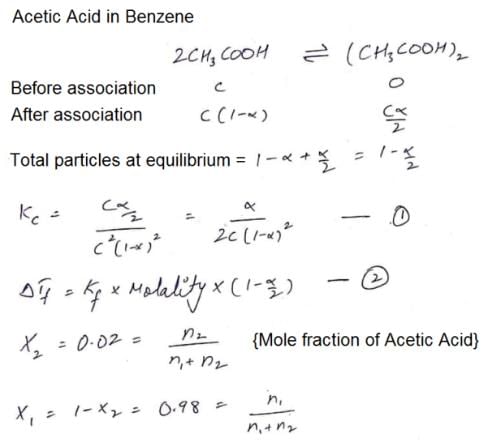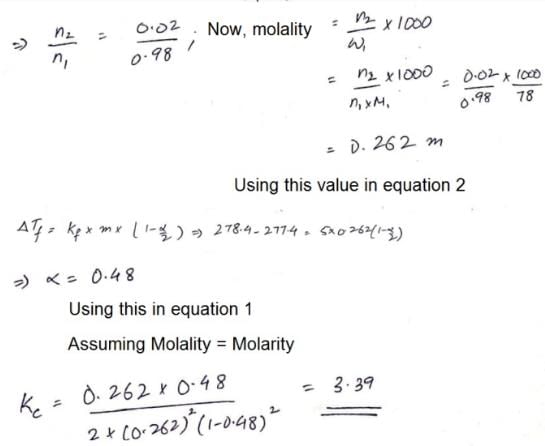Chemistry Exam > Chemistry Questions > The freezing point of a solution of acetic ac...
Start Learning for Free
The freezing point of a solution of acetic acid (mole fraction is 0.02) in benzene is 277.4 K. Acetic acid exists partly as a dimer. Freezing point of benzene is 278.4 K and Kf for benzene is 5 K kg mol–1. The equilibrium constant for dimerisation is ______ kg mol–1:
Correct answer is '3.19'. Can you explain this answer?
| FREE This question is part of | Download PDF Attempt this Test |
Verified Answer
The freezing point of a solution of acetic acid (mole fraction is 0.02...


Hence 3.39 is correct
Most Upvoted Answer
The freezing point of a solution of acetic acid (mole fraction is 0.02...
Solution Explanation:
1. Introduction:
In this problem, we are given the freezing point of a solution of acetic acid in benzene and we need to determine the equilibrium constant for the dimerization of acetic acid. To solve this problem, we will use the concept of freezing point depression and the equation for the freezing point depression constant.
2. Freezing Point Depression:
The freezing point depression is the difference between the freezing points of the pure solvent and a solution of the solute in that solvent. It is directly proportional to the molality of the solute in the solution. The equation for freezing point depression is:
ΔTf = Kf × m
Where:
ΔTf is the freezing point depression
Kf is the freezing point depression constant
m is the molality of the solute in the solution
3. Calculation of Molality:
To calculate the molality of the solute, we need to know the mole fraction of the solute, the freezing point of the solution, and the freezing point of the pure solvent. The formula for molality is:
m = (ΔTf / Kf)
Given:
ΔTf = 278.4 K - 277.4 K = 1 K
Kf = 5 K kg mol^-1
Using the formula, we can calculate the molality as:
m = 1 K / 5 K kg mol^-1 = 0.2 mol kg^-1
4. Relationship between Molality and Mole Fraction:
The mole fraction of a solute is defined as the ratio of the number of moles of the solute to the total number of moles of solute and solvent. In this case, the mole fraction of acetic acid is given as 0.02. The relationship between mole fraction and molality is:
m = (x / (1 - x)) × (M2 / M1)
Where:
x is the mole fraction of the solute
M1 is the molar mass of the solvent
M2 is the molar mass of the solute
5. Calculation of Molar Mass:
To determine the equilibrium constant for dimerization, we need to find the molar mass of acetic acid. The molar mass of acetic acid (CH3COOH) is:
M2 = (12.01 g/mol × 2) + (1.01 g/mol × 4) + (16.00 g/mol) + (1.01 g/mol) = 60.05 g/mol
6. Calculation of Equilibrium Constant:
Now, we can rearrange the equation for the relationship between mole fraction and molality to solve for the equilibrium constant (K):
K = (m × (1 - x) / x) × (M1 / M2)
Substituting the given values:
K = (0.2 mol kg^-1 × (1 - 0.02) / 0.02) × (78.11 g/mol / 60.05 g/mol)
Simplifying the expression:
K ≈ 3.19 kg mol^-1
Therefore, the equilibrium constant for dimerization of acetic acid
1. Introduction:
In this problem, we are given the freezing point of a solution of acetic acid in benzene and we need to determine the equilibrium constant for the dimerization of acetic acid. To solve this problem, we will use the concept of freezing point depression and the equation for the freezing point depression constant.
2. Freezing Point Depression:
The freezing point depression is the difference between the freezing points of the pure solvent and a solution of the solute in that solvent. It is directly proportional to the molality of the solute in the solution. The equation for freezing point depression is:
ΔTf = Kf × m
Where:
ΔTf is the freezing point depression
Kf is the freezing point depression constant
m is the molality of the solute in the solution
3. Calculation of Molality:
To calculate the molality of the solute, we need to know the mole fraction of the solute, the freezing point of the solution, and the freezing point of the pure solvent. The formula for molality is:
m = (ΔTf / Kf)
Given:
ΔTf = 278.4 K - 277.4 K = 1 K
Kf = 5 K kg mol^-1
Using the formula, we can calculate the molality as:
m = 1 K / 5 K kg mol^-1 = 0.2 mol kg^-1
4. Relationship between Molality and Mole Fraction:
The mole fraction of a solute is defined as the ratio of the number of moles of the solute to the total number of moles of solute and solvent. In this case, the mole fraction of acetic acid is given as 0.02. The relationship between mole fraction and molality is:
m = (x / (1 - x)) × (M2 / M1)
Where:
x is the mole fraction of the solute
M1 is the molar mass of the solvent
M2 is the molar mass of the solute
5. Calculation of Molar Mass:
To determine the equilibrium constant for dimerization, we need to find the molar mass of acetic acid. The molar mass of acetic acid (CH3COOH) is:
M2 = (12.01 g/mol × 2) + (1.01 g/mol × 4) + (16.00 g/mol) + (1.01 g/mol) = 60.05 g/mol
6. Calculation of Equilibrium Constant:
Now, we can rearrange the equation for the relationship between mole fraction and molality to solve for the equilibrium constant (K):
K = (m × (1 - x) / x) × (M1 / M2)
Substituting the given values:
K = (0.2 mol kg^-1 × (1 - 0.02) / 0.02) × (78.11 g/mol / 60.05 g/mol)
Simplifying the expression:
K ≈ 3.19 kg mol^-1
Therefore, the equilibrium constant for dimerization of acetic acid

|
Explore Courses for Chemistry exam
|

|
Similar Chemistry Doubts
The freezing point of a solution of acetic acid (mole fraction is 0.02) in benzene is 277.4 K. Acetic acid exists partly as a dimer. Freezing point of benzene is 278.4 K and Kf for benzene is 5 K kg mol–1. The equilibrium constant for dimerisation is ______ kg mol–1:Correct answer is '3.19'. Can you explain this answer?
Question Description
The freezing point of a solution of acetic acid (mole fraction is 0.02) in benzene is 277.4 K. Acetic acid exists partly as a dimer. Freezing point of benzene is 278.4 K and Kf for benzene is 5 K kg mol–1. The equilibrium constant for dimerisation is ______ kg mol–1:Correct answer is '3.19'. Can you explain this answer? for Chemistry 2024 is part of Chemistry preparation. The Question and answers have been prepared according to the Chemistry exam syllabus. Information about The freezing point of a solution of acetic acid (mole fraction is 0.02) in benzene is 277.4 K. Acetic acid exists partly as a dimer. Freezing point of benzene is 278.4 K and Kf for benzene is 5 K kg mol–1. The equilibrium constant for dimerisation is ______ kg mol–1:Correct answer is '3.19'. Can you explain this answer? covers all topics & solutions for Chemistry 2024 Exam. Find important definitions, questions, meanings, examples, exercises and tests below for The freezing point of a solution of acetic acid (mole fraction is 0.02) in benzene is 277.4 K. Acetic acid exists partly as a dimer. Freezing point of benzene is 278.4 K and Kf for benzene is 5 K kg mol–1. The equilibrium constant for dimerisation is ______ kg mol–1:Correct answer is '3.19'. Can you explain this answer?.
The freezing point of a solution of acetic acid (mole fraction is 0.02) in benzene is 277.4 K. Acetic acid exists partly as a dimer. Freezing point of benzene is 278.4 K and Kf for benzene is 5 K kg mol–1. The equilibrium constant for dimerisation is ______ kg mol–1:Correct answer is '3.19'. Can you explain this answer? for Chemistry 2024 is part of Chemistry preparation. The Question and answers have been prepared according to the Chemistry exam syllabus. Information about The freezing point of a solution of acetic acid (mole fraction is 0.02) in benzene is 277.4 K. Acetic acid exists partly as a dimer. Freezing point of benzene is 278.4 K and Kf for benzene is 5 K kg mol–1. The equilibrium constant for dimerisation is ______ kg mol–1:Correct answer is '3.19'. Can you explain this answer? covers all topics & solutions for Chemistry 2024 Exam. Find important definitions, questions, meanings, examples, exercises and tests below for The freezing point of a solution of acetic acid (mole fraction is 0.02) in benzene is 277.4 K. Acetic acid exists partly as a dimer. Freezing point of benzene is 278.4 K and Kf for benzene is 5 K kg mol–1. The equilibrium constant for dimerisation is ______ kg mol–1:Correct answer is '3.19'. Can you explain this answer?.
Solutions for The freezing point of a solution of acetic acid (mole fraction is 0.02) in benzene is 277.4 K. Acetic acid exists partly as a dimer. Freezing point of benzene is 278.4 K and Kf for benzene is 5 K kg mol–1. The equilibrium constant for dimerisation is ______ kg mol–1:Correct answer is '3.19'. Can you explain this answer? in English & in Hindi are available as part of our courses for Chemistry.
Download more important topics, notes, lectures and mock test series for Chemistry Exam by signing up for free.
Here you can find the meaning of The freezing point of a solution of acetic acid (mole fraction is 0.02) in benzene is 277.4 K. Acetic acid exists partly as a dimer. Freezing point of benzene is 278.4 K and Kf for benzene is 5 K kg mol–1. The equilibrium constant for dimerisation is ______ kg mol–1:Correct answer is '3.19'. Can you explain this answer? defined & explained in the simplest way possible. Besides giving the explanation of
The freezing point of a solution of acetic acid (mole fraction is 0.02) in benzene is 277.4 K. Acetic acid exists partly as a dimer. Freezing point of benzene is 278.4 K and Kf for benzene is 5 K kg mol–1. The equilibrium constant for dimerisation is ______ kg mol–1:Correct answer is '3.19'. Can you explain this answer?, a detailed solution for The freezing point of a solution of acetic acid (mole fraction is 0.02) in benzene is 277.4 K. Acetic acid exists partly as a dimer. Freezing point of benzene is 278.4 K and Kf for benzene is 5 K kg mol–1. The equilibrium constant for dimerisation is ______ kg mol–1:Correct answer is '3.19'. Can you explain this answer? has been provided alongside types of The freezing point of a solution of acetic acid (mole fraction is 0.02) in benzene is 277.4 K. Acetic acid exists partly as a dimer. Freezing point of benzene is 278.4 K and Kf for benzene is 5 K kg mol–1. The equilibrium constant for dimerisation is ______ kg mol–1:Correct answer is '3.19'. Can you explain this answer? theory, EduRev gives you an
ample number of questions to practice The freezing point of a solution of acetic acid (mole fraction is 0.02) in benzene is 277.4 K. Acetic acid exists partly as a dimer. Freezing point of benzene is 278.4 K and Kf for benzene is 5 K kg mol–1. The equilibrium constant for dimerisation is ______ kg mol–1:Correct answer is '3.19'. Can you explain this answer? tests, examples and also practice Chemistry tests.

|
Explore Courses for Chemistry exam
|

|
Suggested Free Tests
Signup for Free!
Signup to see your scores go up within 7 days! Learn & Practice with 1000+ FREE Notes, Videos & Tests.


















